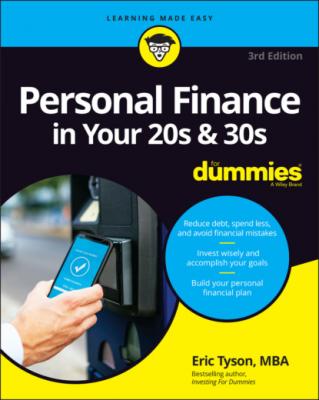Personal Finance in Your 20s & 30s For Dummies. Eric Tyson
Чтение книги онлайн.
Читать онлайн книгу Personal Finance in Your 20s & 30s For Dummies - Eric Tyson страница 18
 also provide opportunities for those whose finances are in order and who have courage and plans!
also provide opportunities for those whose finances are in order and who have courage and plans!
You don’t have to subject yourself to endless advertising nor succumb to its directives. There are plenty of ad blocking tools you can use when online or watching your favorite programs. You can also choose to consume more media that employs less ads.
Making the Most of Loans
Not all debt is bad. In fact, some debt can help you better your life and improve your financial situation in the long run. Taking out a loan for the right reasons can make good financial sense because you’re making an investment. Loans for your education, for buying or starting a small business, or for purchasing real estate can give you a return on your investment. Furthering your education, for example, can increase your income-earning ability. Borrowing to invest in a good piece of real estate or a small business should pay off over the years as well. Despite the potential, however, there’s no guarantee that you’ll earn a return above and beyond your loan’s interest costs. Money may get spent and borrowed on the wrong type of education or an inferior real-estate property, for example.
Dealing With Student-Loan Debt
Higher education can cost big bucks. And as you read this book, you may not be done with this too-often-costly process. Whether it’s finishing a degree or returning to school for some continuing education, you may have education expenditures, perhaps significant ones, in your future.
And, whether all those education costs are behind you now or not, paying off student loans is probably in your future if you’re like most young adults. So, this section will help you to pay off those loans in a manner that best fits with your overall financial situation and that minimizes costs.
Tracking your student loans and making timely payments
You may have multiple types of loans with different loan servicers. It’s your responsibility to keep track of them, provide changes of address as necessary, and pay them on time. All your federal student loans can be found through the U.S. Department of Education’s Federal Student Aid website (studentaid.gov/).
If you fall on hard times (for example, you get laid off from your job) and can’t make a payment, communicate with your loan servicer and request a deferment. While your deferment request may be turned down if your circumstances are deemed not severe enough, you may qualify for forbearance, during which interest continues accumulating on your loans but you stop making payments for up to one year. The pandemic of 2020 caused government student loans to be paused, collections stopped, and interest waived until October 1, 2021. If you fail to get in touch and communicate with your loan servicer when you’re having problems making payments, your credit report will show that you are deliquent on your loans and your credit score will suffer greatly (see Chapters 1 and 4 for more about credit scores).
Prioritizing the payback of student loans
How fast you pay back student loans should be a function of a number of factors. First, if you plan on doing more higher education and possibly applying for any type of financial aid, it generally makes sense to pay the minimum possible on your loans; the more debt you have outstanding, the better positioned you will be to see your future education bills reduced. You can see your repayment options on the website at studentaid.gov/loan-simulator/.
You should be aware of another quirky feature of federal student loans if you’re contemplating working for certain nonprofit or public-sector employers. The Public Service Loan Forgiveness Program may help wipe out your remaining federal student debt after you’ve made ten years of repayments if you work for a qualifying employer such as the federal, state, or local government or a nonprofit organization covered under Section 501(c)(3) of the Internal Revenue Code, or if you’re serving in a full-time AmeriCorps or Peace Corps position. See studentaid.gov/manage-loans/forgiveness-cancellation/public-service for more information.
When weighing which student loans to pay back faster, you should consider the interest rate on your loans. If you have extra cash and would like to pay back your loans faster, start with the ones with the highest interest rate. If the overall interest rates on your student loans are relatively low, don’t miss out on the tax benefits you can earn by funding a retirement savings account, especially if that retirement account offers you free matching money from your employer.
Using education tax breaks
Whether you are finished with your higher education or not, be sure you understand and maximize your use of the U.S. federal government tax benefits relating to those costs. Here’s a summary of key provisions you should know about:
Student-loan interest deduction: You may take up to a $2,500 federal income-tax deduction for student-loan interest that you pay on IRS Form 1040 for college costs as long as your modified adjusted gross income (AGI) is less than or equal to $70,000 for single taxpayers or $140,000 for married couples filing jointly. (Note: Your deduction is phased out if your AGI is between